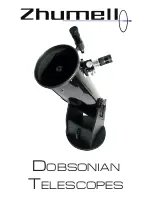
14
Image orientation as seen with the
unaided eye & using erecting
devices on refractors & Newtonians.
Inverted image, normal with
Newtonians & as viewed with
eyepiece directly in a refractor.
Reversed from left to right, as
viewed using a Star Diagonal on a
refractor.
I
I
m
m
a
a
g
g
e
e
O
O
r
r
i
i
e
e
n
n
t
t
a
a
t
t
i
i
o
o
n
n
The image orientation changes depending on how the eyepiece is inserted into the telescope. When using a star
diagonal with refractors, the image is right-side-up, but reversed from left-to-right (i.e., mirror image). If inserting
the eyepiece directly into the focuser of a refractor (i.e., without the diagonal), the image is upside-down and
reversed from left-to-right (i.e., inverted). However, when using the PowerSeeker refractor and the standard erect
image diagonal, the image is correctly oriented in every aspect.
Newtonian reflectors produce a right-side-up image but the image will appear rotated based on the location of the
eyepiece holder in relation to the ground. However, by using the erect image eyepiece supplied with the
PowerSeeker Newtonians, the image is correctly oriented
Figure 3-3
F
F
o
o
c
c
u
u
s
s
i
i
n
n
g
g
To focus your refractor or Newtonian telescope, simply turn the focus knob located directly below the eyepiece
holder (see Figures 2-20 and 2-21). Turning the knob clockwise allows you to focus on an object that is farther
than the one you are currently observing. Turning the knob counterclockwise from you allows you to focus on an
object closer than the one you are currently observing.
Note:
If you wear corrective lenses (specifically glasses), you may want to remove them when observing with an
eyepiece attached to the telescope. However, when using a camera you should always wear corrective lenses to
ensure the sharpest possible focus. If you have astigmatism, corrective lenses must be worn at all times.
C
C
a
a
l
l
c
c
u
u
l
l
a
a
t
t
i
i
n
n
g
g
M
M
a
a
g
g
n
n
i
i
f
f
i
i
c
c
a
a
t
t
i
i
o
o
n
n
You can change the power of your telescope just by changing the eyepiece (ocular). To determine the
magnification of your telescope, simply divide the focal length of the telescope by the focal length of the eyepiece
used. In equation format, the formula looks like this:
Focal Length of Telescope (mm)
Magnification =
Focal Length of Eyepiece (mm)
Let’s say, for example, you are using the 20mm eyepiece that came with your telescope. To determine the
magnification you divide the focal length of your telescope (the PowerSeeker 80EQ for this example has a focal
length of 900mm) by the focal length of the eyepiece, 20mm. Dividing 900 by 20 yields a magnification of 45x.
Although the power is variable, each instrument under average skies has a limit to the highest useful magnification.
The general rule is that 60 power can be used for every inch of aperture. For example, the PowerSeeker 80EQ is
3.1” inches in diameter. Multiplying 3.1 by 80 gives a maximum useful magnification of 189 power. Although this
is the maximum useful magnification, most observing is done in the range of 20 to 35 power for every inch of
aperture which is 62 to 109 times for the PowerSeeker 80EQ telescope. You can determine the magnification for
your telescope the same way.















































